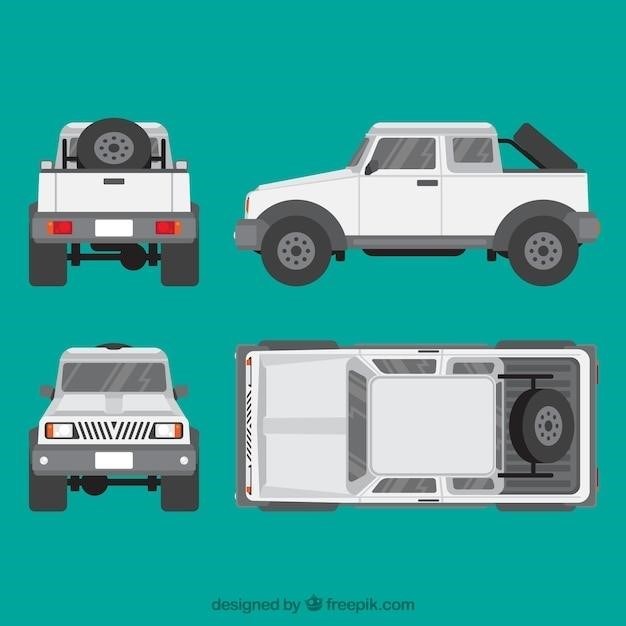
jeep cherokee manual
Jeep Cherokee Manual⁚ A Comprehensive Guide
This comprehensive guide explores everything you need to know about the Jeep Cherokee manual transmission, from its history and evolution to finding and using one, the benefits it offers, troubleshooting, and common issues and solutions. Discover valuable resources and communities for Jeep Cherokee manual enthusiasts, and gain insights into this iconic vehicle’s unique driving experience.
Introduction
The Jeep Cherokee, with its rugged heritage and versatility, has captivated drivers for decades. While automatic transmissions have become the norm in modern SUVs, a passionate group of enthusiasts still seek the engaging and rewarding experience of a manual transmission. This manual transmission option, often overlooked, adds a unique dimension to the Cherokee’s driving character, offering a more direct connection to the vehicle and enhanced control, especially for those who appreciate the thrill of shifting gears themselves. From the iconic XJ model that popularized the Cherokee name to the modern KL generation, the manual transmission has consistently appealed to drivers seeking a more engaging and visceral driving experience. This guide delves into the world of the Jeep Cherokee manual, exploring its history, features, benefits, and everything you need to know to find, use, and maintain this unique and cherished aspect of the Cherokee lineage.
History and Evolution of the Jeep Cherokee
The Jeep Cherokee’s lineage traces back to the 1970s, long before Chrysler acquired the brand. The Cherokee nameplate first appeared on a compact wagon, the SJ, which debuted in 1974. However, it was the introduction of the XJ model in 1984 that truly cemented the Cherokee’s legacy. The XJ, known for its unibody construction and advanced four-wheel drive system, became a popular choice for both on- and off-road adventures. The XJ’s success paved the way for the Cherokee to evolve through subsequent generations, each building upon the foundation established by its predecessor. The Cherokee’s evolution has seen a shift in design, technology, and powertrain options, but the core spirit of rugged capability and versatility has remained constant. From the original XJ’s focus on off-road prowess to the modern KL generation’s emphasis on on-road comfort and technology, the Cherokee has continually adapted to evolving consumer demands while retaining its distinctive character.
The Jeep Cherokee XJ (1984-2001)
The Jeep Cherokee XJ, produced from 1984 to 2001, stands as a landmark in Jeep history. It marked a departure from the traditional body-on-frame construction of its predecessors, adopting a unibody design that provided improved handling and ride quality. The XJ’s unibody construction, paired with its advanced four-wheel drive system, made it a versatile vehicle capable of tackling both on- and off-road challenges. The XJ was initially offered with a range of four-cylinder and six-cylinder engines, providing a balance of power and fuel efficiency. It was also available with a manual transmission, offering drivers a more engaging and connected driving experience. The XJ’s popularity stemmed from its blend of ruggedness, practicality, and affordability, making it a favorite among enthusiasts and families alike. The XJ’s lasting impact on the Jeep Cherokee lineage is evident in its enduring legacy and its influence on subsequent generations.
The Jeep Cherokee KJ (2002-2007)
The Jeep Cherokee KJ, produced from 2002 to 2007, marked a significant shift in the Cherokee’s design and engineering. Replacing the iconic XJ, the KJ adopted a more car-like platform and a more rounded exterior. While this change aimed to improve ride comfort and fuel efficiency, it drew criticism from some enthusiasts who missed the XJ’s rugged and off-road-focused nature. The KJ offered a choice of four-cylinder and six-cylinder engines, along with a five-speed manual transmission. However, the availability of a manual gearbox was limited to certain trim levels and engine options. The KJ also introduced a new independent rear suspension, enhancing ride quality on paved roads but compromising some off-road capability. Despite its evolution, the KJ retained the Cherokee’s reputation for reliability and practicality, making it a suitable choice for families and those seeking a capable and comfortable compact SUV.
The Jeep Cherokee KL (2014-Present)
The Jeep Cherokee KL, launched in 2014, represents a complete departure from its predecessors. It adopted a more modern and sleek design, with a controversial “face” that generated mixed reactions. The KL is built on a unibody platform, prioritizing comfort and handling over rugged off-road capability. While it retains the Cherokee name, its focus shifted towards urban environments and daily driving. The KL offers a range of engine options, including four-cylinder and V6 engines. However, the manual transmission was discontinued for this generation, leaving only automatic options available. The KL features advanced technology and safety features, including an optional nine-speed automatic transmission and a suite of driver-assistance systems. Despite the lack of a manual transmission, the KL remains a popular choice for its versatility, fuel efficiency, and modern amenities.
Jeep Cherokee Manual Transmission Options
The Jeep Cherokee has a rich history of offering manual transmission options, but this has changed significantly over the years. The first-generation XJ (1984-2001) was renowned for its robust manual transmissions, offering a choice of five-speed and six-speed units. These transmissions were durable and well-suited for both on- and off-road driving. The second-generation KJ (2002-2007) also featured manual transmissions, but the availability varied by trim level and market. The five-speed manual became the standard option, providing a balance of performance and efficiency. The third generation (2014-present) marked a significant shift, as Jeep discontinued the manual transmission for the KL model. This decision reflected the growing popularity of automatic transmissions and the emphasis on fuel efficiency in modern vehicles. While the manual transmission is no longer available for the current Cherokee, its legacy continues to be cherished by enthusiasts who appreciate its engaging driving experience and connection to the vehicle.
Finding and Using a Jeep Cherokee Manual
Finding a Jeep Cherokee with a manual transmission can be a bit of a treasure hunt. While the manual transmission was discontinued in later generations, the XJ and KJ models still offer this sought-after option. Online marketplaces like Craigslist and eBay are good starting points, as are specialized Jeep forums where enthusiasts often trade vehicles. Be prepared for a bit of searching and potentially traveling to find the right one. Once you’ve secured a Cherokee manual, it’s important to familiarize yourself with its operation. The manual transmission requires a different driving style than an automatic, focusing on clutch control and gear selection. Take the time to practice in a safe environment, getting a feel for the shifting pattern and clutch engagement point. Learning to drive a manual transmission can be a rewarding experience, allowing you to engage more actively with your vehicle and enjoy a more connected driving experience.
Benefits of a Jeep Cherokee Manual

Driving a Jeep Cherokee with a manual transmission offers a unique blend of driving engagement and practicality that appeals to many enthusiasts. The manual gearbox provides a more direct connection to the engine, allowing for greater control over power delivery and acceleration. This is particularly noticeable when navigating challenging terrain or tackling off-road adventures, where precise gear selection can be crucial. The manual transmission also tends to be more fuel-efficient than its automatic counterpart, especially in city driving, as it allows for smoother and more controlled acceleration. Beyond the driving experience, a Jeep Cherokee manual can also be a valuable asset for those who appreciate the simplicity and longevity of a mechanical system. Manual transmissions are generally more durable and require less maintenance than automatics, making them a reliable choice for long-term ownership. The manual transmission’s inherent mechanical simplicity also makes it easier to repair and maintain in case of any issues.
Troubleshooting and Maintenance
While Jeep Cherokee manuals are known for their durability, regular maintenance is crucial to ensure smooth operation and prevent potential issues. Regular oil changes are essential for maintaining the health of the transmission, as is checking the fluid level and condition. Clutch maintenance is also crucial, including inspecting and adjusting the clutch pedal, replacing the clutch disc and pressure plate as needed, and ensuring proper bleeding of the hydraulic system. Regularly inspecting and replacing the clutch cable or hydraulic lines can prevent unexpected failures. Furthermore, it’s important to inspect and maintain other components associated with the manual transmission, such as the shifter linkage, gear selector, and gear ratios. Proper lubrication and adjustment of these components can prevent wear and tear and ensure smooth gear changes. Be sure to follow the manufacturer’s recommended maintenance schedule and address any unusual noises, shifting difficulties, or fluid leaks promptly. A knowledgeable mechanic specializing in Jeep Cherokee manuals can provide expert advice and guidance on troubleshooting and resolving any issues.
Common Issues and Solutions
While Jeep Cherokee manuals are generally robust, some common issues can arise. One prevalent issue is clutch slippage, which can manifest as a slipping clutch pedal, difficulty engaging gears, or a burning smell. This problem can be caused by worn clutch plates, a faulty hydraulic system, or an issue with the pressure plate. Replacing the clutch assembly or addressing any hydraulic issues can resolve this problem. Another common issue is a noisy transmission, which can be caused by worn gears, bearings, or synchronizers. Diagnosing the specific source of the noise can help determine the necessary repair, which may involve replacing worn components or adjusting the transmission. Additionally, a rough shifting experience can be attributed to various factors, including worn synchros, a damaged shifter linkage, or improper adjustment. Inspecting the shifter linkage, adjusting the transmission, or replacing worn synchros can remedy these issues. Lastly, leaking transmission fluid can indicate a seal failure or damage to the transmission housing. Replacing the faulty seals, repairing any damage, and replenishing the fluid can resolve the leak. Consulting a skilled mechanic specializing in Jeep Cherokee manuals is recommended for accurate diagnosis and efficient repairs.
Resources and Communities
Connecting with fellow Jeep Cherokee manual enthusiasts can provide invaluable support, knowledge, and a sense of camaraderie. Online forums, social media groups, and dedicated websites serve as vibrant hubs for sharing experiences, troubleshooting tips, and discussing all things related to the manual Cherokee. Popular platforms like JeepForum, CherokeeForum, and Reddit’s r/Jeep provide forums specifically dedicated to the Cherokee, where owners can seek guidance, share insights, and find solutions to common challenges. These online communities often offer detailed technical information, repair guides, and firsthand accounts of ownership experiences. Additionally, local Jeep clubs and meetups offer opportunities for in-person interaction, sharing knowledge, and engaging in off-road adventures with fellow enthusiasts. These resources provide a wealth of information, a network of support, and a sense of belonging for anyone seeking to learn more about or maintain their Jeep Cherokee manual transmission.
The Jeep Cherokee manual transmission continues to captivate enthusiasts with its engaging driving experience and unique character. From its rich history and evolution to the benefits it offers in terms of control, fuel efficiency, and a more connected driving experience, the manual Cherokee stands out as a vehicle that rewards its owner with a deeper connection to the road. While finding and maintaining a manual Cherokee might require some extra effort, the rewards are undeniable. The vibrant online communities and resources available provide a wealth of support and knowledge for those seeking to embark on this journey. Whether you’re a seasoned Jeep enthusiast or a newcomer to the world of manual transmissions, the Jeep Cherokee manual offers a unique and rewarding driving experience that continues to attract and inspire generations of drivers.